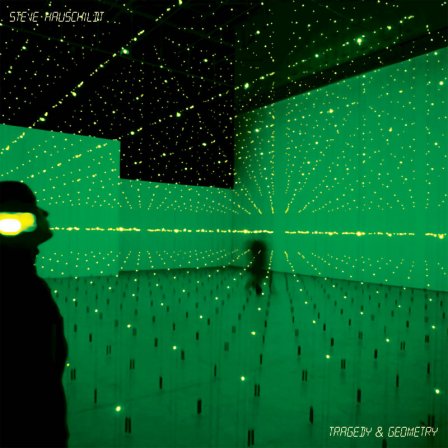Melpomene, muse of tragedy, personifies one half of the conceptual foundation for Steve Hauschildt’s first label-released album, a break from his work as member of the increasingly favorite (among critics and fans) and prolific trio Emeralds. The election of this goddess may not be trivial: kosmische music (which is the main source for Hauschildt’s musical inspiration — or in this case, his selected mousikê) has a latent component of tragedy. Tragic, as the sober and melancholic Teutonic historicism of Klaus Schulze or the abstract and dissonant solemnity of Kluster, both referenced in this album through the mystical brevity of “Arche,” with its primordial, sustained chords tracing a forgotten cosmogony, or the vanishing romanticism of “Cupid’s Dart.” Tragic, also, as the embracing meditation of Ash Ra Tempel or the unearthly voyages of early Tangerine Dream, in which solitude and isolation are inseparable parts of the musical experience, as in the out-of-reach void of closer “Stare Into Space” (an allusion to Urania, perhaps?). Along with this well-known astral-travel tradition, Hauschildt also attempts micro-scaled trips: “Peroxide,” a chemical fantasy that starts in a dense, vaporous state but quickly decomposes into granular motion through a sequencer-catalyzed reaction. But Melpomene was also a chanting goddess, and through her, the tragic becomes expressively melodic, a dramatic and forsaken voice arising from the ineffable myriad of synthetic sounds, as in the whale-like chants at the beginning of the perplexing “Overnight Venusian.”
Polyhymnia, muse of sacred poetry and eloquence — and also geometry — is the second prominent allegory in the album. Once again, the past haunts Hauschildt’s work: eloquent, as the discursive serenity of Hans-Joachim Roedelius; geometric, as the safe and concrete landscape mapping of late Tangerine Dream or Conrad Schnitzler’s calculated sonic diagrams. In “Too Short A Season,” synth loops constantly draw symmetric figures, exploring diverse combinations of the same basic shapes until the sounds try to rearrange into a solid structure: congruent, rational, proportional, supported by the power of an axiomatic truth. “Music For a Moiré Pattern” best exemplifies the fixation with music expressiveness and the properties of space through an optical analogy: metronomic pixel melodies forming persistent lines that interfere with each other, creating perpendicular, fuzzy sequences blinking slightly out-of-sync in a gradual crescendo. A Charles Meynier artwork from 1800 was a specific referent for the track “Polyhymnia” (multiple hymns, four variations on the same synthesized canticle). In the painting, the muse can be seen with a powerful staring gaze, arms extended in front and hands mimicking the act of conjuring a blissful power (or controlling some artifact, e.g., a keyboard instrument), not in a virtuosic or passionate manner, but in a cerebral and restrained way. That is the way Hauschildt operates: improvisations based on steady explorations of the synthesizer, where eloquence arises from applying subtle changes to complex, arpeggiated progressions.
Melpomene and Polyhymnia. Tragedy and Geometry. Technological expansion as both a geometric and tragic event, defining and conquering spaces while simultaneously making the interpersonal human dimension disposable. A related contradiction is present in the actual processes that conceive the music in Tragedy & Geometry, as shown by the exclusive and almost fetishist use of synthesizers while consciously avoiding any sort of computer-generated music.
A visual counterpart to Hauschildt’s music might be constituted by the work of artist Erwin Redl (whose impressive installation MATRIX II is featured in the album cover). Redl employs different arrays of LED units that combine to form several three-dimensional grids projecting different vanishing points and highlighting spaces that can be transited and inhabited. In a similar manner, the music in this album slowly shapes the surrounding substance of the listening space, building a reticulated, synth-orchestrated architecture with countless perspectives. Ultimately, Tragedy & Geometry’s plenty of references to ancient culture and 1970s electronic music configure a rhetoric learned from the great kosmische orators — in the tradition of Demosthenes, whose head sculpture adorns the aforementioned Meynier painting — invoking in that way the weight of history and its cultural significance to Western civilization. All of this, supported by Hauschildt’s idea of future music as an eventual nootropic drug that will dismiss the physicality of sound in exchange for its pure mental experience. While certainly still subjugated to the sensory realm, Tragedy & Geometry, with its network of relentless, vibrating nervous pulses, could be moving a bit closer to that goal.
